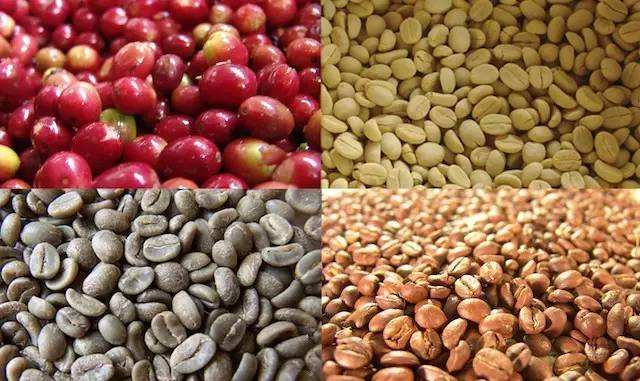Nicaraguan coffee producing area, origin of Nicaraguan coffee beans
Follow the caf é (Wechat official account vdailycom) and found that Beautiful Cafe opened a small shop of its own.
Nicaragua
It is mainly divided into four major producing areas, namely (Segovias), Madaguelba / Henodeka area (Matagalpa/Jinotega), Polgo District (Boaco) and Pacific Coast area (Pacific). The highest planting height in Bosnia and Herzegovina is about 1500-2000, and the coffee produced is the highest SHG (Strictly High Grown).
Planted with volcanic ash and shaded trees, it produces high-quality Nicaraguan coffee with a mediocre, soft and slightly sour flavor, which is suitable for comprehensive coffee. The volume of Nepalese coffee is the largest of all coffee beans, among which the giant beans produced in Madagelba are the most distinctive. This kind of giant bean particles are larger than ordinary coffee beans, commonly known as elephant beans, with a distinctive special flavor, but also with the round texture of Maragogipe coffee, its sister product Matagalpa contains wild acidity and indescribable aroma.
The coffee trees in this area are several ancient bourbon species, which are usually planted on the hillside of 1200 murmur1500 Michael above sea level, and have been recognized as excellent organic coffee at high altitude by the Organic crop improvement Association (OCIA). Nepalese coffee is particularly suitable for deep roasting and is recommended for brewing espresso.

Nicaraguan coffee is mainly produced in the central and northern part of the country, covered with volcanic ash and shaded by trees, resulting in high-quality Nicaraguan coffee, which has a mediocre, mild flavor and is suitable for comprehensive coffee. Shade planting is its characteristic, while coffee beans are washed and dried in the sun. Nicaraguan coffee beans are larger than those of other countries. In particular, Maragogipe (a huge tree species called elephant beans) from Madagelba has a clear taste and excellent aroma, which is highly valued in the market for its round and soft texture.
The cool northeast of Nueva Segovia in New Segovia features steep mountains and jungles with high acidity, short fruits, moderate sweetness and flavors of dark chocolate, cream, citrus, coconut, peach, raisins and cherries. The acidity of this coffee is very close to that of mulberry 1500-2000.
The northeast mountain region of Metagalpa in Madagascar has a cool climate with high acidity, medium volume, high sweetness and fragrant flower fragrance. It is both delicate and smooth, with unique flavors such as chocolate, caramel, fresh fruit, citric acid and so on. This coffee feels smooth and soft 1200-1500
The northeast mountain region of Jinotega in Genotega has a cool climate with high acidity, good fruit quality and moderate sweetness, with a uniform flavor of milk chocolate and a combination of raisins, plums, oranges, peaches, lemons and vanilla 1200-1500
Madriz Madriz has high acidity, short fruit, moderate sweetness and strong tulip aromas. It also contains a variety of fruit juice flavors such as grapefruit, peach, apple, vanilla, honey and cherry.
Estri Estel í has moderate acidity, good fruit quality, moderate sweetness, peach, apricot and other flavors, and has the characteristics of foam. It is a kind of coffee with balanced quality and floral flavor.
Nicaraguan coffee has been forgotten in Taiwan in recent years, and Nicaraguan coffee is rarely seen. In fact, the planting conditions of Nicaragua are not inferior to those of Central American countries. The coffee produced by Nicaragua is characterized by a fresh and balanced taste. What is amazing is that the coffee produced by small farmers is as clean and bright as Costa Rican coffee in shallow roasting, sour, delicate and gentle, and Colombian coffee is sweet and thick when roasted deeply. Mellow and full-bodied taste. Don't underestimate the surprises of Jinotega, Madaguelba and segovia, which are the producers of fine Nicaraguan coffee.
Matagalpa is the coffee producing area that produces the highest quality coffee in Nicaragua, and there is a heavyweight coffee estate worth introducing-the lemon tree (El Limoncillo). The manor is located in the plateau of Matagalpa between 950m and 1300m above sea level, and there are towering coniferous forests around the coffee trees, providing shade for the growth of coffee trees. This allows coffee trees to be exposed to sunlight while protecting them from being burned by the scorching sun.
In order to ensure the quality of coffee, the manual picking method is used to pick the fully ripe fruits one by one, which usually takes three times to complete. Although the manual picking method has high labor cost and low picking efficiency, it can greatly protect the plant from being hurt in the picking process, and the mature fruit will have better sweetness at the same time. The efforts of the producers have not been in vain, and the coffee from Lemon Manor won the second place in the Nicaragua Excellence Cup COE National Competition in 2008. This bean has a beautiful appearance, delicate and rich flavor after washing, with aromas of fruit, vanilla and cream, and has gained more attention since then.
Lemon Tree Manor also processes coffee in a honey-treated way. After the coffee fruit is actually picked, the coffee with its exocarp removed is put on the African shed to dry. Compared with the traditional way of placing coffee directly on the ground to dry coffee, using African shed to dry coffee can reduce more pollution in the drying process, avoid producing more miscellaneous smell, and finally improve the quality of coffee. Honey-treated coffee beans have more attractive tropical fruit flavors.
The coffee beans with exquisite flavor presented in front of us, whether from the links of picking, planting, processing, or later packaging and transportation, are all devoted to the good intentions of the producers, in the process of taking the coffee system as something in the cup, we should also treat it attentively.
Important Notice :
前街咖啡 FrontStreet Coffee has moved to new addredd:
FrontStreet Coffee Address: 315,Donghua East Road,GuangZhou
Tel:020 38364473
- Prev

Nicaraguan coffee flavor description, Nicaraguan coffee producing area
Following the comments (Wechat official account vdailycom) found that Nicaragua is an economically backward agricultural country, one of the poorest countries in Central America, with high unemployment rate and people living in poverty, while coffee is Nicaragua's pillar industry, producing nearly 100,000 tons of coffee beans every year. Due to the poor economic foundation, the coffee industry is still relatively backward.
- Next

Coffee varieties in Santos, Brazil. Yield Red bourbon varieties Coffee beans Flavor characteristics Taste description
Pay close attention to coffee reviews (Weixin Official Accounts vdailycom ) and find a beautiful cafe to open its own small shop Brazilian coffee, which refers to coffee produced in Brazil. Brazilian coffee comes in many varieties, and like other Arabica coffees, Brazilian coffee is called Brazils to distinguish it from Milds coffee. The vast majority of Brazilian coffee is unwashed and dried, depending on the state of origin and port of shipment.
Related
- Detailed explanation of Jadeite planting Land in Panamanian Jadeite Manor introduction to the grading system of Jadeite competitive bidding, Red bid, Green bid and Rose Summer
- Story of Coffee planting in Brenka region of Costa Rica Stonehenge Manor anaerobic heavy honey treatment of flavor mouth
- What's on the barrel of Blue Mountain Coffee beans?
- Can American coffee also pull flowers? How to use hot American style to pull out a good-looking pattern?
- Can you make a cold extract with coffee beans? What is the right proportion for cold-extracted coffee formula?
- Indonesian PWN Gold Mandrine Coffee Origin Features Flavor How to Chong? Mandolin coffee is American.
- A brief introduction to the flavor characteristics of Brazilian yellow bourbon coffee beans
- What is the effect of different water quality on the flavor of cold-extracted coffee? What kind of water is best for brewing coffee?
- Why do you think of Rose Summer whenever you mention Panamanian coffee?
- Introduction to the characteristics of authentic blue mountain coffee bean producing areas? What is the CIB Coffee Authority in Jamaica?

